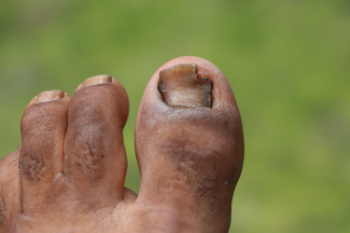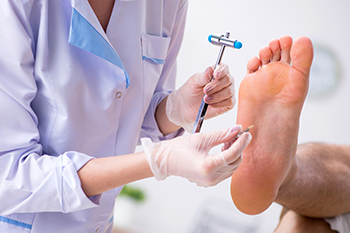Items filtered by date: May 2024
Symptoms and Treatment of Fungal Toenails

Toenail fungus, medically known as onychomycosis, affects a significant portion of the population, with fungal toenail infections being more common than those of the fingernails. These fungal toenail infections can cause discomfort and affect nail appearance. Common symptoms include nail discoloration, thickening, and fragility, along with separation from the nail bed. Fungal toenail infections are caused by various environmental fungi that enter through small nail or skin cracks. Certain factors, such as age, nail trauma, diabetes, weakened immunity, and poor circulation can increase he risk of fungal toenail infections. Diagnosis requires laboratory testing to differentiate fungal infections from other nail problems. Treatment usually involves prescription antifungal medication, which is most effective when started early. However, recurrence is possible, especially in individuals with predisposing conditions like diabetes. If you have developed symptoms of fungal toenails, it is suggested that you schedule an appointment with a chiropodist for treatment.
Toenail fungus can be uncomfortable and unsightly. If you have diabetes or a compromised immune system, it may also be dangerous. To learn more about treatment options, please consult with one of the chiropodists from Complete Family Footcare & Therapy. Our clinicians will assess your condition and provide you with quality foot and ankle treatment.
What Does Toenail Fungus Look Like?
A fungal infection of the toenail may cause the affected nail to become thickened, brittle, crumbly, and yellowish or brown in color. Sometimes the toenail may separate from the nail bed, become deformed, emit a foul odor, or cause pain or discomfort.
What Causes Toenail Fungus?
Toenail fungus is caused by a fungus that infects the nail bed. The fungus lives and thrives in warm and moist environments and is also contagious. Athlete’s foot, which is a fungal infection of the skin, may spread to the nails and cause toenail fungus.
What Treatments Are Available?
Potential treatments for toenail fungus may include oral antifungal medications, topical antifungal medications, such as medicated nail polishes that are applied directly to the affected nail, and laser therapy. Sometimes, a combination of treatments is prescribed.
If you have any questions, please feel free to contact our offices located in . We offer the newest diagnostic and treatment technologies for all your foot care needs.
Chiropodists Offer Expert Care for Foot Health

A chiropodist is a healthcare professional specializing in the diagnosis, treatment, and prevention of foot and ankle disorders. These specialists undergo extensive training in podiatric medicine and surgery to address a wide range of foot ailments and promote optimal foot health. Chiropodists play a vital role in assessing and managing various conditions such as ingrown toenails, corns, calluses, plantar fasciitis, and diabetic foot complications. Their scope of practice encompasses conducting thorough examinations, ordering diagnostic tests, and formulating individualized treatment plans tailored to each patient's needs. Treatment modalities may include medication and custom orthotic devices. Additionally, chiropodists educate patients about preventive foot care practices, proper footwear selection, and lifestyle modifications to mitigate the risk of future complications. With their expertise and dedication, chiropodists help individuals maintain optimal foot health, alleviate discomfort, and improve overall quality of life. If you have developed any type of foot pain, it is strongly suggested that you seek guidance from a chiropodist who can accurately diagnose and treat conditions relating to the feet and ankles.
If you have any foot or ankle concerns, contact one of the chiropodists of Complete Family Footcare & Therapy. Our clinicians can provide the care you need to keep you on your feet.
A chiropodist is a healthcare professional that specializes in the feet, ankles, and lower limbs. With the amount of work the feet do in a lifetime, the whole body works better if the feet are properly supported. Chiropodists must have a bachelor’s degree in science and complete a three to four-year chiropody program. They can then work independently or as part of a team. Chiropodists are like podiatrists, the only difference being the country they obtained where they obtained their degrees. The field can be called podiatry in the United States and chiropody elsewhere. A chiropodist is a popular term for this profession in the UK and Canada. Chiropodists treat a variety of foot problems from corns and calluses to fungal infections. Some also offer orthotics. They might provide a variety of foot therapies, injections, and surgical procedures. Normally one sees a chiropodist when they are experiencing pain but visiting one regularly, as one would a dentist, can help ensure the feet are in top form and help prevent future problems. If you suffer from foot or ankle pain or have questions about your lower extremities, book an appointment with a chiropodist today.
What Does a Chiropodist Do?
A chiropodist helps people with problems with their feet and ankles with the goal of making their lives more comfortable. A chiropodist takes care of blisters, corns, bunions, cracked heels, nail problems, and sprained ankles, just to mention a few things that can go wrong with our feet. A chiropodist will take your medical history and examine your feet for blood circulation and any other problems going on. They will watch you walk and how you move when you walk. They will discuss any findings they come up with and discuss a treatment plan with you.
What Does It Take to Become a Chiropodist?
Chiropodists must have seven to eight years of post-secondary school before beginning to practice. They must obtain a bachelor’s degree in science and complete a three-to-four-year chiropody program. Chiropodists work independently or as part of a team.
If you have any questions please feel free to contact our offices located in North York and Mississauga, ON . We offer the newest diagnostic tools and technology to treat your foot and ankle needs.
Problems Caused by Wearing Flip Flops

Despite their popularity for easy slip-on wear and breathability, flip flops may be detrimental to your foot health. Although flip flops might appear ideal for warm weather, they lack the necessary support and stability for everyday use. Blisters can develop due to friction between toes and straps, particularly when moisture is present. Heel pain, such as plantar fasciitis, often arises from the absence of adequate arch support, resulting in excessive stretching of ligaments. Also, the design of flip flops increases the risk of sprained ankles over time. Walking in flip flops can cause shin splints due to overworked leg muscles. While wearing flip flops suffice for light activities, such as trips to the beach or as protective footwear in gym showers, they are ill-suited for prolonged wear or physical exertion. It is more advisable to choose supportive footwear when engaging in strenuous tasks as a way of preventing foot and leg discomfort. If you are experiencing foot pain related to wearing flip flops, it is suggested that you schedule an appointment with a chiropodist who can offer tailored advice and appropriate treatment.
Flip-flops, though they may seem harmless, are bad for your foot health. If you would like to learn more about the many problems that can be caused by frequent flip-flop wear, please consult with one of the chiropodists from Complete Family Footcare & Therapy. Our clinicians can help you maintain the health of your lower limbs and your mobility.
Flip-flops are the quintessential summer shoe, seemingly perfect for the beach or pool. Unfortunately, these flimsy shoes are not a good choice when it comes to keeping your feet healthy.
Frequently wearing flip-flops is associated with:
Hammertoes
Bunions
Plantar fasciitis
Heel spurs
Cracked heels
Plantar warts
Athlete’s foot
Foot pain
Foot and ankle injuries
Gait changes
Leg, hip, and back pain
The best way to avoid these issues is to swap your flip-flops for more protective and supportive shoes. If you must wear flip-flops, wear them only for short periods of time.
If you have any questions, please feel free to contact our offices located in . We offer the newest diagnostic and treatment technologies for all your foot care needs.
Medical Conditions Behind Cracked Heels

Cracked heels can be more than just a cosmetic concern, as they can often indicate underlying medical conditions that require attention. One common reason for cracked heels is dry skin, which occurs when the skin lacks moisture and becomes thick and rough, leading to fissures and cracks. However, several medical conditions can exacerbate this issue. For instance, eczema and psoriasis can cause dry, itchy skin that may lead to cracking, while thyroid disorders can disrupt the body's ability to produce adequate oils, resulting in dry skin. Diabetes is another significant contributor, as it can lead to nerve damage and poor circulation, making the skin more susceptible to dryness and cracking. Additionally, fungal infections such as athlete's foot can cause dry, flaky skin on the heels, which may crack if left untreated. If you have developed cracked heels, it is suggested that you visit a chiropodist who can effectively treat this condition, in addition to determining what the cause is.
Dry, cracked heels are more than a cosmetic inconvenience. For many people, they are uncomfortable, deep, painful, and may even bleed. If you suffer from cracked heels, please consult with one of the chiropodists from Complete Family Footcare & Therapy. Our clinicians can help you maintain the health of your lower limbs and your mobility.
Causes
Prolonged standing
Wearing open-back shoes
Wearing shoes that don’t cushion the heels
Living in a cold or dry climate
Taking long, hot showers
Not moisturizing the heels
Eczema
Psoriasis
Palmoplantar keratoderma
Juvenile plantar dermatosis
Treatments
Soaking the feet
Exfoliating with a pumice stone
Moisturizing the heels
Wearing closed-back shoes that cushion heels
Avoiding prolonged standing
Taking warm, rather than hot, showers
Treating underlying skin conditions
While milder cases of cracked heels can be treated at home, some patients present with deep, painful, bleeding heel fissures that are at risk of becoming infected and may require medical care. Additionally, patients with diabetes or any other conditions that affect the immune system should be monitored by a chiropodist.
If you have any questions, please feel free to contact our offices located in . We offer the newest diagnostic and treatment technologies for all your foot care needs.

